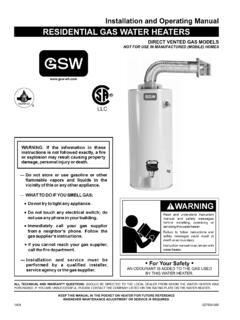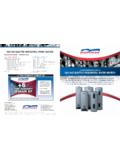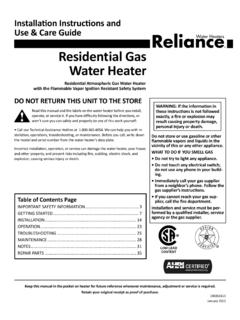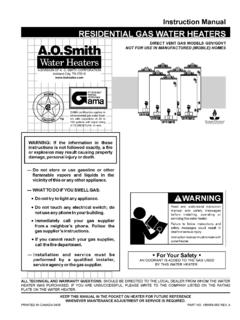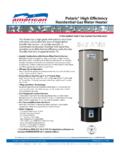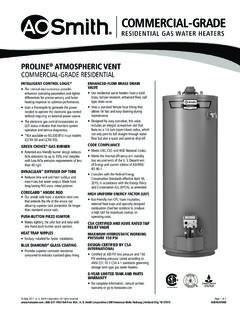Transcription of GAS: RESIDENTIAL REQUIREMENTS FOR INSTALLATION OF …
1 GAS: RESIDENTIAL REQUIREMENTS FOR INSTALLATION OF GAS PIPING AND/OR APPLIANCES (2003 INTERNATIONAL RESIDENTIAL CODE) PERMITS: The INSTALLATION of gas piping and/or gas appliances requires permit(s) and inspection(s) , It is unlawful to connect gas piping/appliances to gas fuel supply until inspection and or approval. Proposed Work: Permit Required Addition of gas piping and the INSTALLATION of gas appliance or heating unit where no Plumbing electrical* or mechanical work is involved. Addition of gas piping and the INSTALLATION of gas heating unit where mechanical and /or Mechanical electrical is involved. *Electrical work necessary for the INSTALLATION of bond wire(s) and lighting (as required by code) is allowed without an addit ional electrical permit.
2 INSPECTIONS: Rough Plumbing Gas piping is inspected prior to being covered or concealed to insure that the type, size and INSTALLATION meet the building code. The piping must be pressure tested at not less than 1 and times the proposed maximum working pressure, but not less than 3 psig. 10 lbs. of air will usually meet this requirement. The test duration shall be not less than 10 minutes. The installer is responsible for performing the test. This test must be witnessed by the Gila County Building Inspector. Bonding will also be inspected at this time. , , , Rough Mechanical Gas appliances/heating units and ductwork are inspected in accordance with the manufacturer s INSTALLATION instructions and the REQUIREMENTS of the building code. Heating units are inspected for source of supply of combustion air and exhaust venting.
3 The manufacturer s INSTALLATION and operating instructions must be attached to the appliance. , A Green Tag indicates that the INSTALLATION has passed inspection. The unit cannot be connected to a gas fuel supply until the INSTALLATION has been inspected and approved. Final The installer is responsible for testing the gas piping system at operating pressure and leak testing the completed gas system. The appliance installer is responsible for confirming that the gas appliance/heating unit installed is operating correctly and safely. , 3. GAS PIPING AND SHUTOFFS: 1.) Gas piping shall be: For a Site-Built Home Wrought iron or steel (galvanized or black) Yellow brass containing less than 75% copper Corrugated stainless steel tubing Approved PVC or PE pipe (exterior buried piping system only) And must be new or never have been used to convey anything but gas.
4 G2414 For a Manufactured Home All distribution piping will be pre-installed from the factory and any alterations or additions to the system will require the use of appropriate materials and methods and plans or a letter from the Contractor describing the changes to be made. Permits and inspections are required. Note: see the Manufactured Home INSTALLATION handout for more details. 2.) Gas piping cannot be installed in or on the ground under any building or structure. Exposed gas piping must be a minimum 3 inches above grade or structure. Gas piping can be run in the ground under a concrete slab in sleeving as long as there is not a roof over the concrete slab. 3.) Metallic pipe or tubing exposed to corrosive action, such as soil condition or moisture, shall be protected in an approved manner.
5 Zinc coatings (galvanizing) shall not be deemed adequate protection for gas piping underground. These coatings and wrappings shall be approved for the application and shall be factory applied except where installed in accordance with the manufacturer s INSTALLATION instructions, field application of coatings and wrappings shall be permitted for pipe nipples, fittings and locations where the factory coating or wrapping has been damaged or necessarily removed at joints , 4.) Ferrous gas piping requires 12 inches of earth cover (18 inches in Mfg. Home Parks) Plastic gas piping requires 18 inches of earth cover with a # 18 tracer wire attached and terminating above grade at each end and caution tape laid in trench 6 above pipe. The trench must remain open for inspection.
6 (Amended), 5.) LPG (storage) facilities piping and main shutoff shall be located outside the building. G2420 6.) Each gas appliance shall have an accessible shutoff valve ahead of the union to the appliance and in addition to any valve provided on the appliance. This valve shall be within 6 feet, accessible, and in the same room as the appliance it serves. G2420 4. To Conduct a Gas Pressure Test: Pressurize the entire system (from the meter to the appliance flex connectors) with air, CO2 or nitrogen to not less than 1 times the proposed maximum working pressure, but not less than 3 psig. 10lbs. of air will usually meet this requirement. The test duration shall be not less than 10 minutes. This test must be witnessed by the Gila County Building Inspector.
7 , , Location of Gas Appliance/Heating Unit: 1.) Appliances installed in garages or areas where they may be subject to damage must be located out of the normal path for vehicles, behind protective barriers, or installed with a minimum clearance of 6 feet above the floor. , 2.) Heating and cooling equipment (includes electric and gas furnaces and water heaters) located in a garage which generates a glow, spark or flame capable of igniting flammable vapors must be installed with pilots and burners at least 18 above floor level. , Combustion Air 1.) Gas water heater(s) /furnace(s) located in a confined space must be provided with at least 100 square inches of outside co mbust ion air within 12 inches of the floor and 100 square inches of relief air within 12 inches of the ceiling.
8 Increase at a rate of 1 square inch per 1000 BTU/h. 2.) Combustion air may be drawn from outside the building, attics (with so me restrictions), under floor areas and interior spaces. (Combustion air may not be drawn from a garage due to flammable vapors.) , , , 3.) See manufacturer s INSTALLATION and operating manual for size of combustion air openings or ducts. Venting 1.) See manufacturer s INSTALLATION and operating manual for venting REQUIREMENTS , methods and vent termination. 2.) See manufacturer s INSTALLATION and operating manual for vent clearances from combustibles. Temperature and Pressure Relief 1.) The temperature and pressure relief drain line: a.) Must be the same size as the T&PR valve outlet. b.) Must be made of either galvanized steel, hard drawn copper, CPVC (chlorinated polyvinyl chloride) pipe, or PB (polybutylene) pipe.
9 C.) Cannot be trapped, shall be installed so as to drain by gravity flow and shall terminate atmospherically not less than 6 inches or more than 24 inches above the finish floor (by indirect connection into a floor drain) or finish grade with an unthreaded end. Amended, 5. PROHIBITED LOCATIONS Water Heaters which depend on the combustion of fuel for heat shall not be installed in a room used or designed to be used for sleeping purposes, bathroom, storage closet or other confined space opening into a bath or bedroom. EXCEPTION: Direct vent water heaters Where not prohibited by other regulations, water heaters may be located under a stairway landing. Warm-air Furnaces shall not be installed in a room used or designed to be used as a bedroom, bathroom or in any enclosed space with access only through such room or space.
10 EXCEPTION: Direct vent furnaces, enclosed furnaces and electric heating furnaces. Access to furnaces located in an attic or under-floor crawl space may be through a closet. Warm-air Furnaces shall not be installed outside a building unless listed for exterior INSTALLATION or enclosed in a waterproof housing. Other Methods of installing LPG burning appliances may be acceptable but are subject to approval. Inspection may be required prior to issuing a permit. Bonding and Grounding 1.) Underground ferrous gas piping shall be electrically isolated from the rest of the gas system with a dielectric union (approved isolation fitting) installed 6 inches minimum above ground. 2.) Metal (gas) piping which may become energized shall be bonded (on the house side of the dielectric union) to the service panel.

